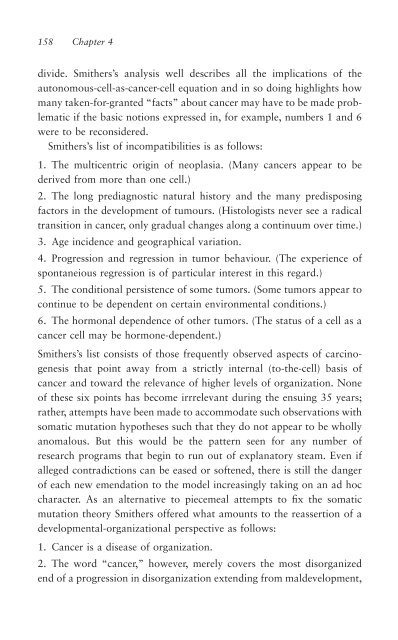A Critique of Pure (Genetic) Information
A Critique of Pure (Genetic) Information
A Critique of Pure (Genetic) Information
Create successful ePaper yourself
Turn your PDF publications into a flip-book with our unique Google optimized e-Paper software.
158 Chapter 4<br />
divide. Smithers’s analysis well describes all the implications <strong>of</strong> the<br />
autonomous-cell-as-cancer-cell equation and in so doing highlights how<br />
many taken-for-granted “facts” about cancer may have to be made problematic<br />
if the basic notions expressed in, for example, numbers 1 and 6<br />
were to be reconsidered.<br />
Smithers’s list <strong>of</strong> incompatibilities is as follows:<br />
1. The multicentric origin <strong>of</strong> neoplasia. (Many cancers appear to be<br />
derived from more than one cell.)<br />
2. The long prediagnostic natural history and the many predisposing<br />
factors in the development <strong>of</strong> tumours. (Histologists never see a radical<br />
transition in cancer, only gradual changes along a continuum over time.)<br />
3. Age incidence and geographical variation.<br />
4. Progression and regression in tumor behaviour. (The experience <strong>of</strong><br />
spontaneious regression is <strong>of</strong> particular interest in this regard.)<br />
5. The conditional persistence <strong>of</strong> some tumors. (Some tumors appear to<br />
continue to be dependent on certain environmental conditions.)<br />
6. The hormonal dependence <strong>of</strong> other tumors. (The status <strong>of</strong> a cell as a<br />
cancer cell may be hormone-dependent.)<br />
Smithers’s list consists <strong>of</strong> those frequently observed aspects <strong>of</strong> carcinogenesis<br />
that point away from a strictly internal (to-the-cell) basis <strong>of</strong><br />
cancer and toward the relevance <strong>of</strong> higher levels <strong>of</strong> organization. None<br />
<strong>of</strong> these six points has become irrrelevant during the ensuing 35 years;<br />
rather, attempts have been made to accommodate such observations with<br />
somatic mutation hypotheses such that they do not appear to be wholly<br />
anomalous. But this would be the pattern seen for any number <strong>of</strong><br />
research programs that begin to run out <strong>of</strong> explanatory steam. Even if<br />
alleged contradictions can be eased or s<strong>of</strong>tened, there is still the danger<br />
<strong>of</strong> each new emendation to the model increasingly taking on an ad hoc<br />
character. As an alternative to piecemeal attempts to fix the somatic<br />
mutation theory Smithers <strong>of</strong>fered what amounts to the reassertion <strong>of</strong> a<br />
developmental-organizational perspective as follows:<br />
1. Cancer is a disease <strong>of</strong> organization.<br />
2. The word “cancer,” however, merely covers the most disorganized<br />
end <strong>of</strong> a progression in disorganization extending from maldevelopment,
















